How the Automobile Age Made Motels
By: James Wilder
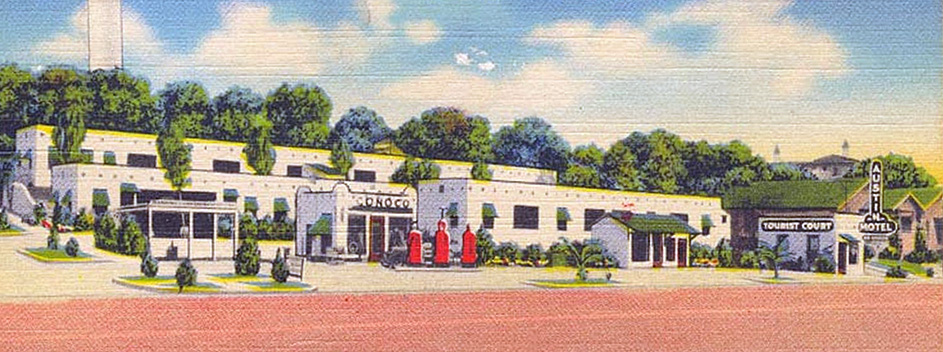
Austin Motel postcard: The Austin Motel on Congress Avenue (So close yet so far out) was built in 1938 and still exists today.
Along with drive-in movie theaters and drive-in restaurants, the motel owes its existence to the automobile.
In fact, Henry Ford envisioned everyone will own an automobile and they will use it to "enjoy with his family the blessing of hours of pleasure in God's great open spaces." Sounds like a road trip to me!
This article will lead you through some of the key events that brought us the modern motel, such as:
- The Birth of the Automobile Industry.
- Auto camping was cool, for a while.
- Cabins, cottages and courts spring up.
- The Texan that accelerated Texas highways.
- The word "Motel" seemed to stick.
- Motor courts are now endangered.
To get a better understanding about where the motel came from, we start with the automobile.
The Birth of the Automobile Industry 1895
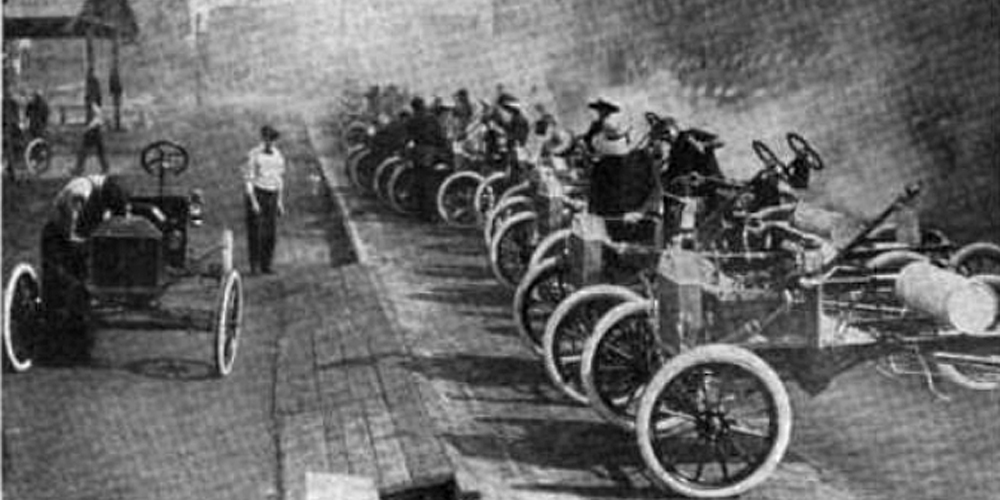
Ford plant testing 1200 automobiles a day. Motor Age 1914.
For thousands of years we relied on our feet and horses for transportation. It was rare that anyone traveled the dusty roads to destinations afar.
Then came a revolution.
The industrial revolution kicked off a chain of mechanical inventions that eventually led to the rise of the steam train in the early 1800s.
But while the railroads were racing to connect major cities, the automobile entered the scene and made transportation personal again (my hero!).
Inventors and entrepreneurs saw the opportunity of motorized travel and began putting steam, gasoline and electric motors on horse carriages. Of course they did! Because that was cool.
The first company in the United States to produce gasoline powered automobiles was the Duryea Motor Wagon Company, founded in 1895.
By 1899 there were thirty automobile companies in the United States.
Initially, the automobile was a novelty for the rich. However, doctors found the automobile quite useful for making house calls.
In the early 1900s, even if you were well-to-do, and owned an automobile, you couldn't travel too far. There were no paved roads, no gas stations and no travel maps (Tip: follow the railroad tracks and you'll be safe).
Meanwhile, Henry Ford had a vision. In his book "My Life and Work" he stated the following:
"I will build a motor car for the great multitude. It will be large enough for the family, but small enough for the individual to run and care for. It will be constructed of the best materials, by the best men to be hired, after the simplest designs that modern engineering can devise. But it will be so low in price that no man making a good salary will be unable to own one and enjoy with his family the blessing of hours of pleasure in God's great open spaces."
In 1908, Ford realized his vision with the Model T. Continuous improvements in the assembly line would bring the price of the Model T down year after year. By 1925 a Model T touring car cost less than half what it cost in 1908!
By 1920, roads improved, routes were established, maps were published and you could count on finding gasoline before you ran out. Now anyone could be an explorer of nearby towns or distant lands.
But, if your journey was more than a day you had a problem - there was no place to stay.
Tin Can Tourist Camps 1919 - 1926
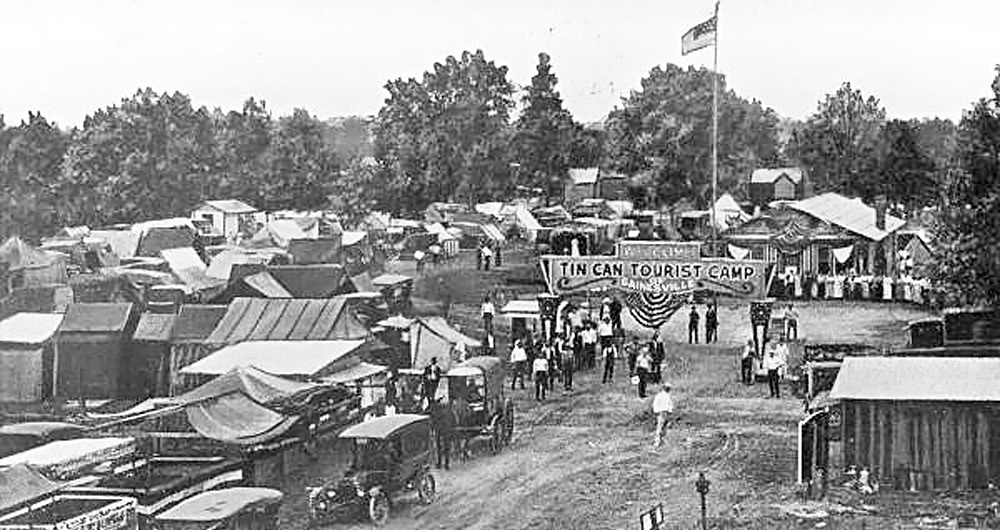
Tin Can Tourist Camp at Gainesville, Florida, 1920s.
Even though the first automobile arrived in Texas in 1899, it wasn't until 1919 that people started venturing beyond their towns in their automobiles.
Some reasons automobile tourism took off were:
- World War I ended in 1918.
- Automobile ownership became more affordable.
- Engineering and maintenance of roads began to improve.
- Routes were established by car clubs (seriously!).
- Maps and guides began to be published.
- You could find gasoline before you ran out.
For those that ventured out, finding lodging and a safe place to park was not easy. Neither was predicting your arrival time to the next town.
If you were going to travel by automobile, you had to count on camping under the stars.
Travelers would usually pack a tent, some cooking utensils and even portable ovens.
As roadside camping became more common, camp grounds began to spring up.
They had all sorts of names: tourist camps, auto camps or auto parks.
These travelers also gained the name "tin can tourists" because they left a mess of discarded tin cans. This was a few years before the "Don't mess with Texas" campaign.
Cities recognized the tourism potential and started offering free camp sites, typically at a local park. They attracted the travelers by providing lighting and bathrooms. They also supplied security to ensure the safety of guests.
Guess what happened next?
Yep, like all good things, someone comes along and ruins it. They never leave. They hog the services. They are loud and obnoxious.
Free didn't last too long. The city run parks started charging a nominal fee and established time limits on how long you could stay. They also made all guests check in, and check out.
Eventually, city run camps grew weary of dealing with unsavory guests and complaints from citizens. Hotel owners were resentful that the city was taking business away from them (so they thought).
After a few years of dealing with complaints from citizens and businesses they were all to happy to say bon voyage to the municipal tourist camp experiment.
Motor Courts Entice Travelers
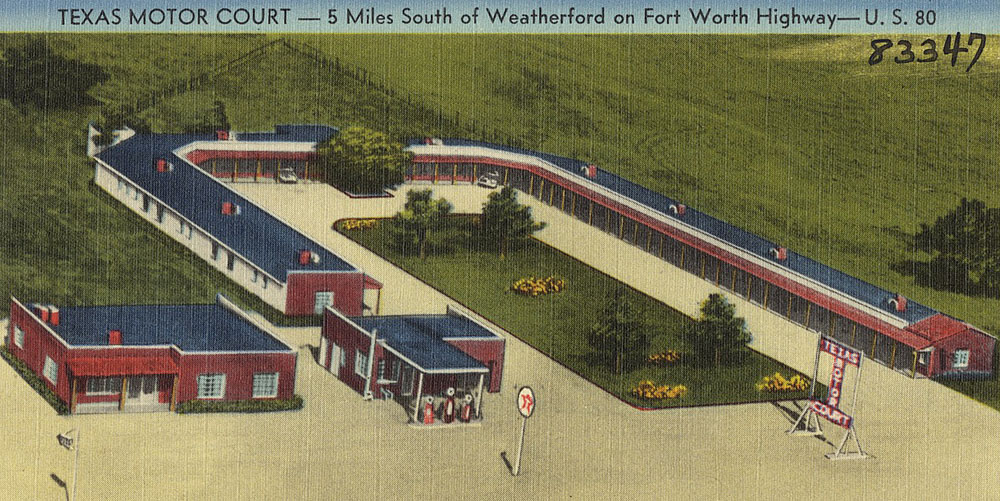
Texas Motor Court - 5 miles south of Weatherford on Fort Worth Highway.
As demand for lodging increased, entrepreneurs began offering travelers an alternative to city run tourist camps.
Instead of camp grounds, common facilities and loud obnoxious freeloaders, they offered rooms with private bathrooms, clean bedding and a kitchen to cook your beans. Some even provided covered parking right next to your room so you could keep an eye (or ear) on your Studebaker.
Eventually, these new facilities began to adopt a common architecture. The buildings were typically designed in a deep U configuration. Many included a garage between each room (see postcard above). The U shape created an inner court, which provided a sense of security.
To further attract travelers, and distinguish themselves from their competitors, some would design ornate drive-through entrances. These drive-through entrances made you feel like you have arrived at a destination, rather than an overnight campout on the way to somewhere else.
The court concept caught on and "motor courts" began to appear on the main roads in and out of town.
Texas Highways Accelerate 1945
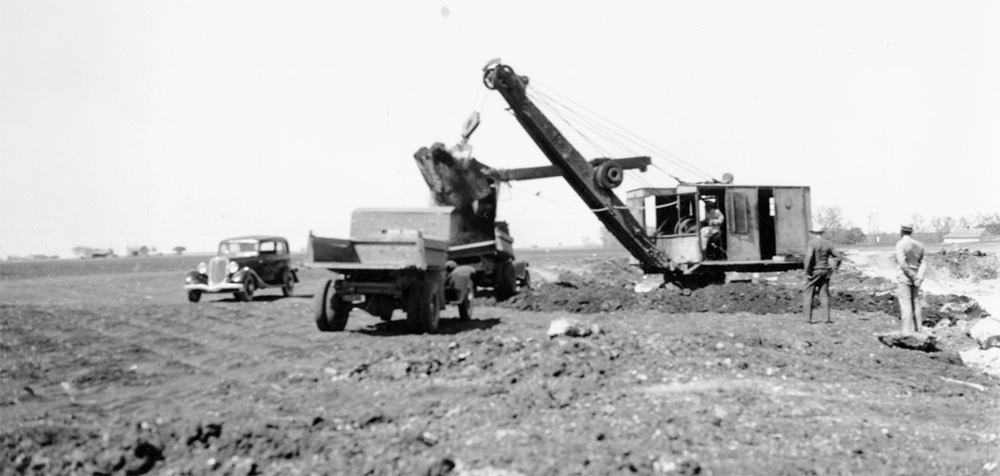
Texas Department of Transportation. [Loading gravel base on U.S. Highway 79], photograph, 1936.
Are we there yet?
Almost.
Before we get to the motel, we should acknowledge that without well designed roads, none of this tourism stuff would be possible.
You might not know this, but Texas highways lagged behind most every state in the Union before World War II! We were also one of the last states to create a state highway department.
But there was one Texan determined to change that!
In 1940, DeWitt C. Greer was appointed state highway engineer.
Greer had a passion to see Texas as having the best highway system in the U.S.
Like all states in the union, the Depression and WWII put road building on the back burner.
Mr. Greer knew he couldn't build highways due to the war. So he put the highway department engineers in design mode and focused on designing the state's highway system.
When the war ended, highway funds became available. Greer shifted gears and moved from design mode to construction.
Texas once lagged behind other states in road building. With Greer's vision and leadership, Texas could now boast of having the best roads in the nation.
The darkness of the depression and World War II were over. No longer did citizens have to ration gasoline and raw materials.
Automobile production increased and there seemed to be a sense of prosperity.
Alright. Onward to motels.
Modern Motels 1950s
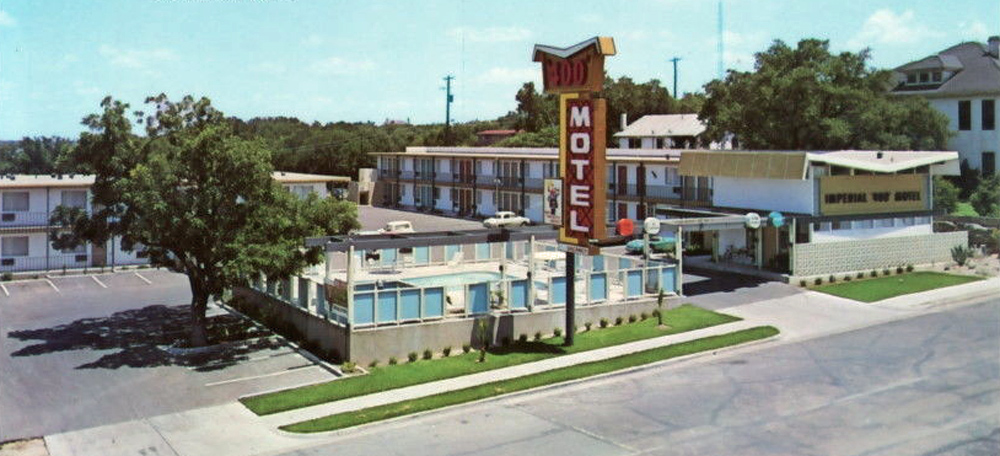
Imperial '400' Motel, was located at 901 South Congress.
Lodging for automobile travelers continued to evolve, with owners adding more comfort and amenities. The name "motel" became preferred over the older names, such as motor court, tourist court or Motor-Hotel.
The need for a covered garage integrated as part of the building became less important. Motel owners could have more rooms without those garages in the way. Besides, cars could handle most weather conditions with ease and valuables could be safely locked up in the trunk.
The inner court concept remained, but now it featured a swimming pool and playground for the kids. You could even eat at the motel restaurant! Why leave the motel?
The motel became the destination.
Summary
In the early 1920s, automobile ownership became more common, roads began to improve, and automobile owners began to travel beyond their towns.
Initially, roadside camping was the best option for lodging. But entrepreneurs saw the opportunity to meet the motorists needs by providing safe comfortable lodging.
The motel was created to meet the automotive traveler's needs with all the comforts of home.
Some of the original motor courts still exist today. Next time you drive through a small town keep an eye on the buidlings along main street. You will probably spot them. Some are abandoned. Some are low-income housing. But some are still alive and well.
Credits
View of the Tin Can Tourists camp - Gainesville, Florida. 19--. Black & white photoprint, 8 x 10 in. State Archives of Florida, Florida Memory. www.floridamemory.com/items/show/29400, accessed 27 July 2016.
Texas Department of Transportation. [Loading gravel base on U.S. Highway 79], photograph, 1936; (texashistory.unt.edu/ark:/67531/metapth129034/: accessed July 27, 2016), University of North Texas Libraries, The Portal to Texas History, texashistory.unt.edu; crediting Texas Department of Transportation.